Remove the front case.
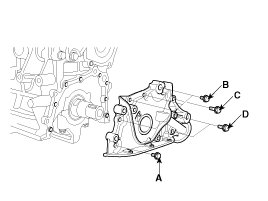
Remove the screws (B) from the pump housing, then separate the housing and cover (A).
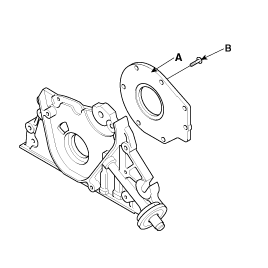
Remove the inner (A) and outer (B) rotors.
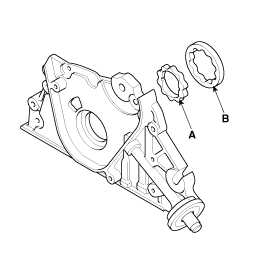
Prolonged and repeated contact with mineral oil will result in the removal of natural fats from the skin, leading to dryness, irritation and dermatitis. In addition, used engine oil contains potentially harmful contaminants which may cause skin cancer.
Exercise caution in order to minimize the length and frequency of contact of your skin to used oil. Wear protective clothing and gloves. Wash your skin thoroughly with soap and water, or use water-less hand cleaner, to remove any used engine oil. Do not use gasoline, thinners, or solvents.
In order to preserve the environment, used oil and used oil filter must be disposed of only at designated disposal sites.
Drain engine oil.
Remove the oil filter cap.
Remove the oil drain plug, and drain the oil into a container.
Replace oil filter.
Remove the oil filter.
Check and clean the oil filter installation surface.
Check the part number of the new oil filter is as same as old one.
Apply clean engine oil to the gasket of a new oil filter.
Lightly screw the oil filter into place, and tighten it until the gasket contacts the seat.
Tighten it an additional 3/4 turn.
Refill with engine oil filter.
Clean and install the oil drain plug with a new gasket.
Tightening torque :
Aluminum : 39.2 ~ 49.0N.m (4.0 ~ 5.0kgf.m, 28.9 ~ 36.2lb-ft)
Steel : 34.3 ~ 44.1N.m (3.5 ~ 4.5kgf.m, 25.3 ~ 32.5lb-ft)
Fill with fresh engine oil
Capacity
Total : 4.1L (4.33US qts, 3.60lmp qts)
Oil pan : 3.7L (3.91US qts, 3.26lmp qts)
Drain and refill including oil filter : 4.0L (4.23US qts, 3.25lmp qts)
Install the oil filter cap.
Start engine and check for oil leaks.
Recheck engine oil level.
Drain engine oil.
Remove the drive belts.
Turn the crankshaft and align the white groove on the crankshaft pulley with the pointer on the lower cover.
Remove the timing belt.
Remove the oil pan and oil screen.
Remove the front case.

Remove the screws (B) from the pump housing, then separate the housing and cover (A).

Remove the inner (A) and outer (B) rotors.

Remove the relief plunger.
Remove the plug(A), spring(B) and relief plunger(C).
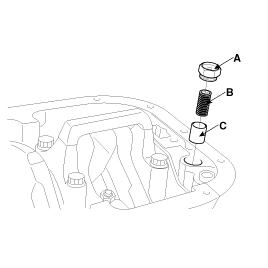
Install relief plunger.
Install relief plunger(C) and spring(B) into the front case hole, and install the plug(A).
Tightening torque
39.2 ~ 49.0N.m (4.0 ~ 5.0kgf.m, 28.9 ~ 36.2lb-ft)

Inspect relief plunger.
Coat the valve with engine oil and check that it falls smoothly into the plunger hole by its own weight.If it does not, replace the relief plunger. If necessary, replace the front case.
Inspect relief valve spring.
Inspect for distorted or broken relief valve spring.
Standard value
Free height : 43.8mm (1.724 in.)
Load : 3.7kg/40.1mm (8.14 lb/1.579 in.)
Inspect rotor side clearance.
Using a feeler gauge and precision straight edge, measure the clearance between the rotors and precision straight edge.
Side clearance | Outer gear | 0.04 ~ 0.09mm (0.0016 ~ 0.0035in.) |
Inner gear | 0.04 ~ 0.085mm (0.0016 ~ 0.0033in.) |
If the side clearance is greater than maximum, replace the rotors as a set. If necessary, replace the front case.
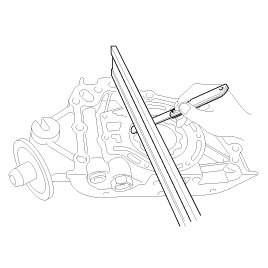
Inspect rotor tip clearance.
Using a feeler gauge, measure the tip clearance between the inner and outer rotor tips.
Tip clearance
0.025 ~ 0.069 mm(0.0010 ~ 0.0027 in.)
If the tip clearance is greater than maximum, replace the rotor as a set.
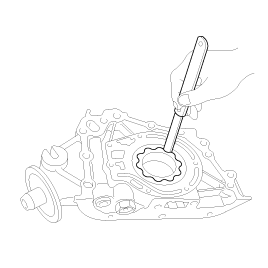
Inspect rotor body clearance
Using a feeler gauge, measure the clearance between the outer rotor and body.
Body clearance
0.12 ~ 0.185 mm(0.0047 ~ 0.0073 in.)
If the body clearance is greater than maximum, replace the rotors as a set. If necessary, replace the front case.
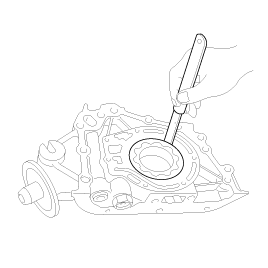
Recommendation (except Middle East) : 5W-20/GF4&SM (If not available, refer to the recommended API or ILSAC classification and SAE viscosity number.)
API classification : SL, SM or above
ILSAC classification : GF3, GF4 or above
SAE viscosity grade : Refer to the recommended SAE viscosity number.
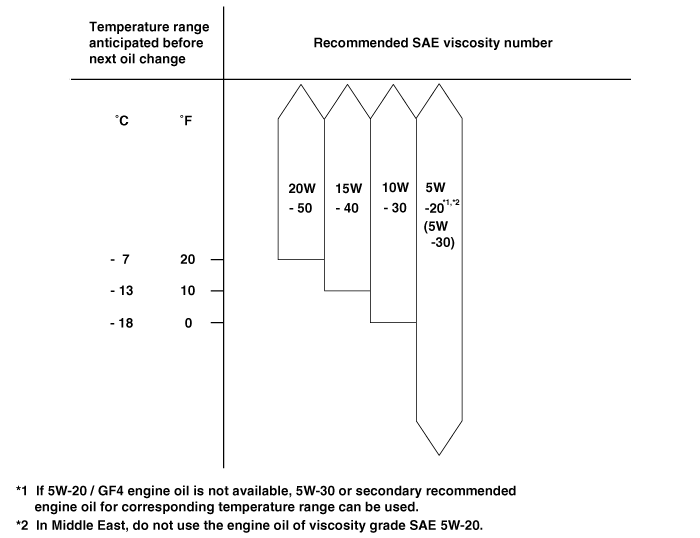
For best performance and maximum protection of all types of operation, select only those lubricants whitch :
Satisfy the requirement of the API or ILSAC classification.
Have proper SAE grade number for expected ambient temperature range.
Lubricants that do not have both an SAE grade number and API or ILSAC service classification on the container should not be used.
Check engine oil quality.
Check the oil for deterioration, entry of water, discoloring or thinning.
If the quality is visibly poor, replace the oil.
Check engine oil level.
After warming up the engine and then 5 minutes after the engine stop, oil level should be between the “L” and “F” marks on the dipstick.
If low, check for leakage and add oil up to the “F” mark.
Do not fill with engine oil above the “F” mark.
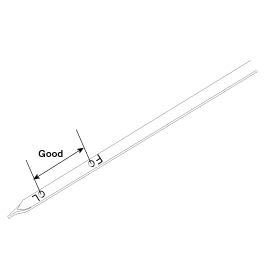
Install oil pump.
Place the inner and outer rotors into front case with the marks facing the oil pump cover side.
Install the oil pump cover (A) to front case with the 7 screws(B).
Tightenig torque
5.9 ~ 8.8N.m (0.6 ~ 0.9kgf.m, 4.3 ~ 6.5lb-ft)

Check that the oil pump turns freely.
Install the oil pump on the cylinder block.
Place a new front case gasket on the cylinder block. Apply engine oil to the lip of the oil pump seal. Then, install the oil pump onto the crankshaft. When the pump is in place, clean any excess grease off the crankshaft and check that the oil seal lip is not distorted.

Body length
(A) : 25mm (0.98 in)
(B) : 20mm (0.787 in)
(C) : 38mm (1.496 in)
(D) : 45mm (1.771 in)
Tightening torque :
19.6 ~ 26.5N.m (2.0 ~ 2.7kgf.m, 14.5 ~ 19.5 lb-ft)
Apply a light coat of oil to the seal lip.
Using the SST(09231-23100), install the oil seal.
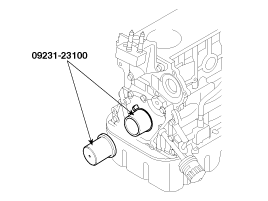
Install the oil screen.
Install the oil pan.
Clean the oil pan gasket mating surfaces.